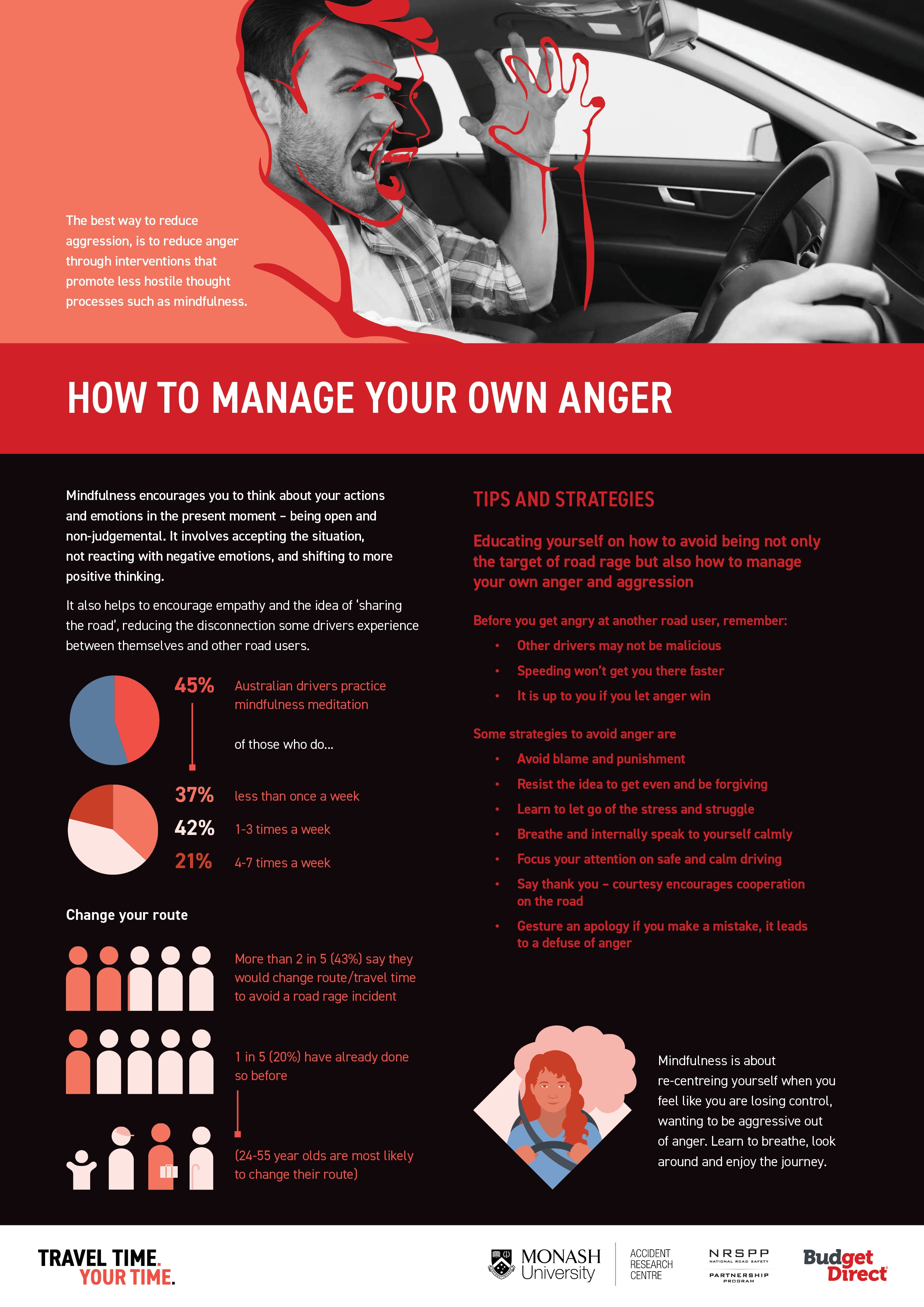NRSPP Fact Sheet: Aggressive Driving – How To Manage Your Own Anger
This Resource Is Part Of The Travel Time. Your Time. Aggressive Driving Campaign.
Download The Full Resource Pack Here
The best way to reduce aggression, is to reduce anger through interventions that promote less hostile thought processes such as mindfulness. Mindfulness encourages you to think about your actions and emotions in the present moment – being open and non-judgemental. It involves accepting the situation, not reacting with negative emotions, and shifting to more positive thinking.
Author Acknowledgement
This campaign has also been developed in collaboration with Jerome Carslake (NRSPP), Gabrielle Fetalvero (NRSPP Swinburne Intern 2019/20), Kristin Cooke (MUARC Swinburne Intern 2019/2020), Caitlin Xavier (NRSPP Swinburne Intern 2020/21), Amanda Stephens (MUARC), Yacine Khouzami (Budget Direct), and Tim Roberts (Fleet Strategy).
References
- Budget Direct 2020, National YouGov Survey on Aggressive Driving
- Dingus, T. Guo, F. Antin, J. (2016). Driver crash risk factors and prevalence evaluation using naturalistic driving data. Proceedings of the National Academy of Sciences, 113(10). 10.1073/pnas.1513271113 (https://www.researchgate.net/publication/295673760_Driver_crash_risk_factors_and_prevalence_evaluation_using_naturalistic_driving_data)
- CarrsQ. (2014). Aggressive Driving – State of the Road. https://research.qut.edu.au/carrsq/wp-content/uploads/sites/45/2017/04/Aggressive-Driving-screen.pdf
- Stephens, A. Ohtsuka, K. (2014). Cognitive biases in aggressive drivers: Does illusion of control drive us off the road? Personality and Individual Differences, 68, pg 124–129. https://doi.org/10.1016/j.paid.2014.04.016. (https://www.sciencedirect.com/science/article/pii/S0191886914002426)
- Stephens, A. Groeger, J. Driven by Anger: The Causes and Consequences of Anger during Virtual Journeys.
- Stephens, A. Lennon, A. Bihler, C. Trawley, S. The measure for angry drivers (MAD). (2019). Transportation Research Part F, 64, pg 472–484. https://doi.org/10.1016/j.trf.2019.06.002. (https://www.sciencedirect.com/science/article/abs/pii/S1369847819302013?via%3Dihub)
- Stephens, A. Fitzharris, M. The frequency and nature of aggressive acts on Australian roads. (2019). Journal of the Australasian College of Road Safety, 30 (3).
- Stephens, A. Koppel, S. Young, K. L. Chambers, R. Hassed, C. Associations between self-reported mindfulness, driving anger and aggressive driving. (2018). Transportation Research Part F: Traffic Psychology and Behaviour, 56, pg 149–155. https://doi.org/10.1016/j.trf.2018.04.011. (https://www.sciencedirect.com/science/article/abs/pii/S1369847817307234?via%3Dihub)
- Stephens, A. Trawley, S. Ohtsuka, K. Venting anger in cyberspace: Self-entitlement versus self-preservation in #roadrage tweets. Transportation Research Part F: Traffic Psychology and Behaviour, 42, pg 400-410. https://doi.org/10.1016/j.trf.2016.01.006. (https://www.sciencedirect.com/science/article/abs/pii/S1369847816000073?via%3Dihub)
- Steindl, S. Kirby, J. (August 5, 2016). Road rage: Why normal people become harmful on roads. The Conversation. https://theconversation.com/road-rage-why-normal-people-become-harmful-on-the-roads-60845
- Virginia Tech Daily. (2016). Researchers determine driver risks using large-scale, crash-only naturalistic database. https://vtnews.vt.edu/articles/2016/02/022316-vtti-researchdistraction.html
- Bowden, E. (August 1, 2017). Melbourne’s road rage hotspots revealed as rate of assaults in Victoria doubles. The Age. https://www.theage.com.au/national/victoria/melbournes-road-rage-hotspots-revealed-as-rate-of-assaults-in-victoria-doubles-20170727-gxjuhd.html
- News.com.au. (July 18, 2017). Almost 90 per cent of Victorian drivers admit to being aggressive on the road. https://www.news.com.au/technology/motoring/almost-90-per-cent-of-victorian-drivers-admit-to-being-aggressive-on-the-road/news-story/486c4d09c50db51e0bce7ad3285f0d14




